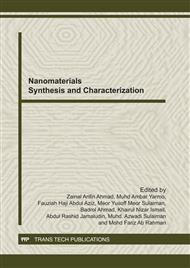p.65
p.70
p.76
p.81
p.86
p.90
p.95
p.100
p.105
Solvent Effects on the Electrical and Optical Properties of Nanocomposited MEH-PPV:TiO2 Films for Organic Solar Cells Application
Abstract:
The influence of organic solvent on the electrical and optical behavior of poly [2-methoxy-5-(2-ethylhexyloxy-p-phenylene-vinylene)] (MEH-PPV): Titanium Dioxide (TiO2) active layer has been investigated. The performance of the nanocomposite thin films varied depending on different type of solvent (chloroform, tetrahydrofuran (THF), toluene, xylene and 1,3-Dicholorobenzene) to dissolve MEH-PPPV at concentration of 20 mg/20ml. The solvent used to dissolve MEH-PPV has a dramatic effect on the polymer properties and characteristics due to different chain interaction, crystalline structure formation and surface morphology. The electrical properties of nanocomposited MEH-PPV: TiO2 thin films were measured by solar simulator in dark and under AM 1.5, 100 mW/cm2 white light illumination condition while the characterization of optical properties has been done using UV-VIS spectrophotometer to evaluate the absorbance as well as the transmittance. By comparing the nanocomposite thin films with the same weight MEH-PPV: TiO2, it was found the thin film which used 1,3-Dicholorobenze as a solvent has the highest conductivity around 338.64x103 S.m-1. However for the optical properties, solvent of xylene gives the highest absorption coefficient at 8.4x106 m-1. The dispersion of nanocomposited MEH-PPV:TiO2 and film formation reproducibility, these solvents showed that its affected film resistance and dispersion stability in the thin films.
Info:
Periodical:
Pages:
86-89
Citation:
Online since:
October 2011
Keywords:
Price:
Сopyright:
© 2012 Trans Tech Publications Ltd. All Rights Reserved
Share:
Citation:



